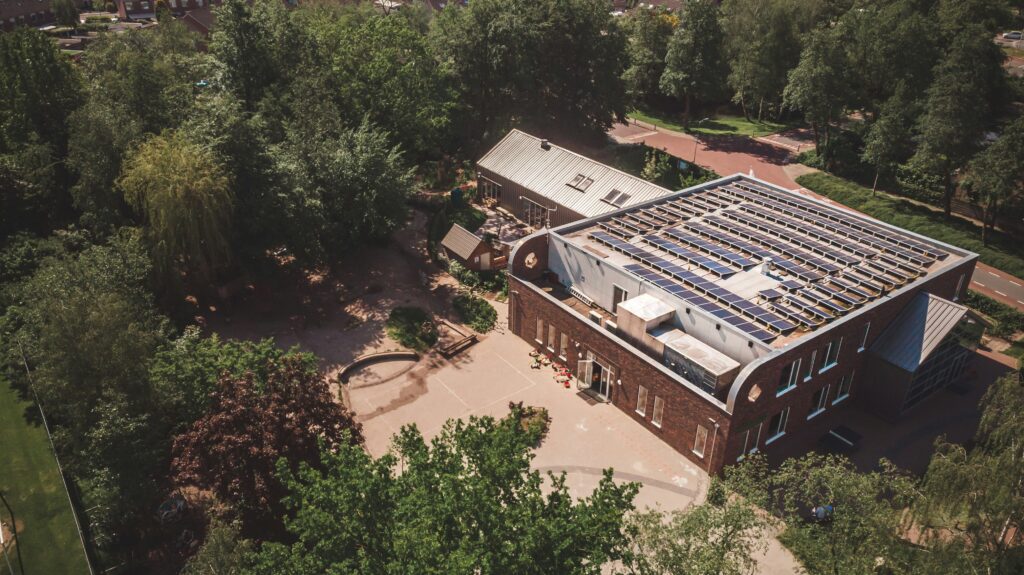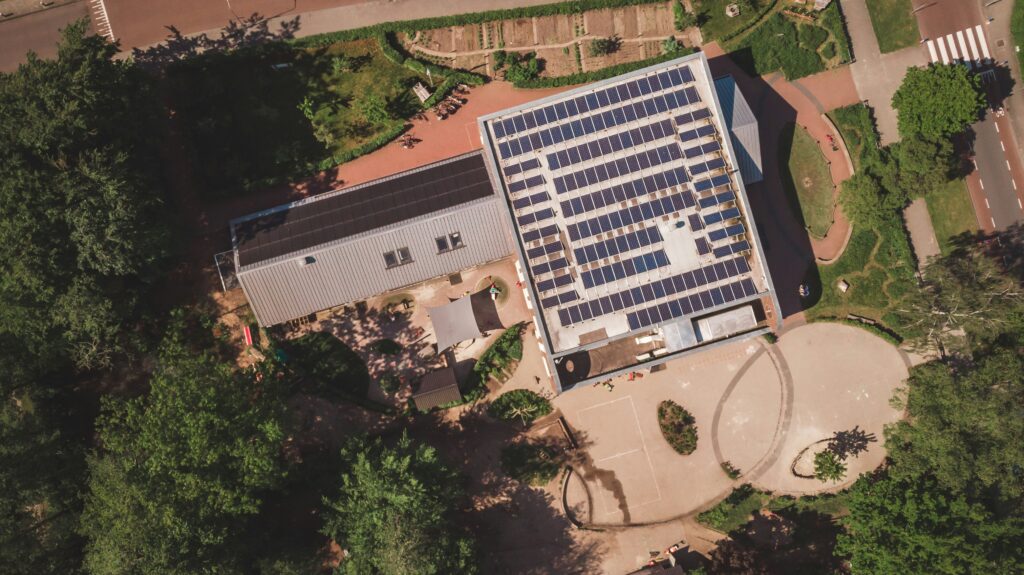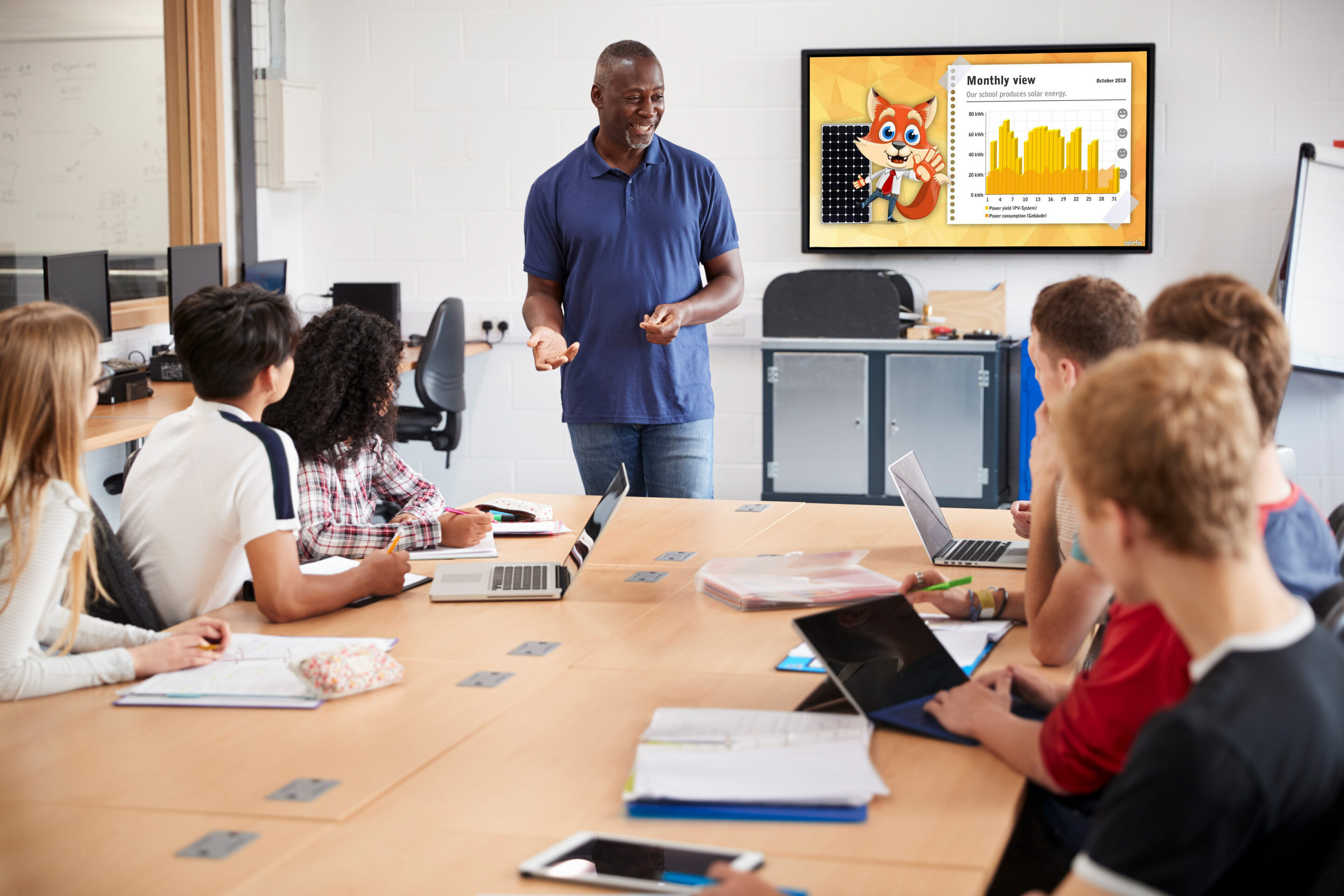Across the UK, more and more schools are finding creative ways to integrate renewable energy into their teaching. With funding from initiatives like Great British Energy, schools are installing solar panels on rooftops and other buildings to reduce costs and promote sustainability. Government support and investment in renewable energy for schools have enabled thousands of panels to be installed, particularly on school rooftops, making a significant impact on energy savings. But beyond generating clean power, many schools are using PV displays to make the impact of renewable energy visible. These interactive screens show real-time solar data and help students, teachers, and visitors understand how solar energy works. The sun is the source of energy for these systems, and students learn about its crucial role in powering solar panels and supporting the transition to clean energy.
By turning technical information into engaging visuals, Solarfox displays make sustainability part of everyday learning. They transform numbers into stories, showing how much energy the school is producing, how much CO₂ is being saved, and how renewable energy contributes to a cleaner future. Universities are also adopting similar PV display technologies and integrating them into their sustainability initiatives. These displays help communicate the urgency of climate change and the importance of reducing carbon emissions, making environmental challenges more tangible for students and staff. In Ireland, Solarfox has already equipped around 500 schools with such displays, helping them integrate renewable energy education into daily school life. These initiatives have helped schools save millions in energy costs, meaning more money can be reinvested into educational resources, staff, and other priorities, giving schools more money for their essential needs.
How can solar panels become classroom learning resources?

Solar installations can do far more than reduce energy bills. They serve as valuable teaching tools that demonstrate how renewable energy works in real time. By engaging with PV displays, students learn practical skills and gain a hands-on understanding of energy generation, sustainability, and engineering principles. These experiences build knowledge relevant to sustainability and renewable energy, preparing students for future challenges. The displays also act as a feedback system, encouraging energy-saving behaviors by making energy use visible. Teachers can use live energy data to explain electricity production, CO₂ savings, and how weather affects performance. PV displays help students monitor energy consumption in real time. Students can track daily solar production, compare sunny and cloudy days, and discuss how renewable energy supports a cleaner planet.
This practical approach makes science, maths, and geography lessons more engaging and relatable. Instead of abstract theories, pupils see real data from their school’s solar system. For a typical school, solar panels are often installed on school buildings, and these displays highlight both financial savings and environmental benefits, making sustainability more accessible. Students can also track and discuss the school’s daily energy budget using the displays. Many schools report that students show greater interest in science and environmental topics when they can see renewable energy in action. These learning experiences can inspire students to pursue careers in renewable energy or sustainability.
How do interactive energy displays improve learning experiences?
Interactive energy displays bridge the gap between technology and education. Systems like Solarfox displays present solar energy data in an easy-to-understand visual format. Instead of reading complex numbers, students see colourful charts showing how much electricity was generated today, this month, or this year, as well as how much CO₂ was saved. These displays can also deliver targeted messages that encourage sustainable behavior, using visual cues and prompts to nudge students and staff toward energy-saving actions.
These displays spark curiosity. Pupils might ask questions like: How much power did our school produce today? How much CO₂ did we save this week? How does our energy use compare to previous months? Drawing on principles from behavioural psychology, the design of these displays uses feedback and educational tools to influence and reinforce positive energy-saving behaviors. Teachers can turn these questions into classroom discussions or sustainability projects. With regular updates, interactive displays make learning dynamic and connect lessons directly to real-world environmental impact.
When schools openly share their energy data, they set an example for others by promoting transparency and encouraging similar practices in other institutions.
Why should schools invest in Solarfox displays?
Solarfox displays are designed specifically for educational environments. They connect to the school’s PV monitoring system and translate technical data into clear, inspiring messages. The displays show live generation, consumption, and savings, making renewable energy visible and understandable to everyone on campus. These systems are often implemented with support from government or institutional programs, which provide funding and resources to facilitate the adoption of solar and other renewable energy solutions.
Schools can customise their Solarfox display to include photos, student projects, or sustainability updates. This turns it into a storytelling platform that connects renewable energy to the wider school community and fosters a sense of shared sustainability among students, staff, and local communities. In entrance halls, canteens, or corridors, visitors can instantly see how much clean energy is being produced. These visual insights encourage climate awareness and highlight the school’s role in promoting sustainability.
In Ireland, around 500 schools are already using Solarfox displays to share their renewable energy achievements. These displays help make sustainability a core part of daily school life, inspiring both students and staff to engage with energy management in a meaningful way. In addition to solar, Solarfox displays can also showcase other renewable energy sources, such as wind and biomass, broadening the educational impact.
How can renewable energy become part of school culture?

Bringing renewable energy into school culture is about more than just installing solar panels. It’s about fostering a mindset of sustainability that benefits future generations and ensures long-term environmental and economic impacts. With the help of PV displays, schools can make progress visible and inspire environmental awareness across the community. Teachers can assign projects where students take the lead in analysing data trends, design posters about solar energy, or create reports on the school’s energy savings.
These interactive tools also engage parents, children, and visitors. During open days or science fairs, schools can showcase their achievements and demonstrate how solar energy supports both the curriculum and the environment, helping to allocate more resources towards children’s education. Some schools even extend this idea to other renewable sources, like wind or biomass, to provide a broader understanding of sustainable energy.
How can schools measure success and inspire change?
Success isn’t only about the number of kilowatt-hours generated. It’s also about awareness, education, and behavioural change. Schools using Solarfox displays often see students take an active role in energy conservation. In many cases, excess solar energy generated by school installations can be fed back into the grid, supporting broader energy goals and demonstrating real-world impact. Pupils learn to think critically about their energy use and share those lessons at home, creating a ripple effect of sustainability.
Interactive energy displays make achievements tangible by showing CO₂ savings, total energy produced, and equivalences like how many trees the school has saved. For instance, a student group at Greenfield Primary used solar data from their PV display to launch an energy-saving campaign that reduced electricity use by 20% in one term. Universities such as the University of Nottingham have also adopted PV displays to educate students about sustainability and integrate renewable energy data into campus life. By visualising data, schools make sustainability measurable, motivating, and inspiring.
Certain schools and universities lead in adopting solar education displays, setting benchmarks for others and inspiring further innovation in sustainability education.
What are the next steps for schools interested in solar education?
Schools interested in adopting renewable energy displays can start by assessing their solar potential. Installing solar panels on rooftops or other suitable buildings maximises efficiency and educational value. To further enhance these benefits, schools should consider integrating complementary technologies such as batteries or energy storage solutions, which can maximize savings and improve energy efficiency. Choosing systems with data export features or API compatibility allows schools to connect directly to interactive displays like Solarfox.
Workshops for teachers and students can help integrate solar energy data into the curriculum. From tracking energy trends to calculating CO₂ savings, students gain valuable STEM experience while learning about real-world sustainability.
Adding a Solarfox display completes the learning loop. It turns a technical installation into an educational tool that makes energy visible. Students, teachers, and visitors can follow the school’s renewable journey and understand how small changes contribute to a larger environmental goal. Having a clear plan for implementing solar education displays and related technologies ensures long-term success and maximizes community benefits.
Why visibility matters in school renewable energy projects
Renewable energy projects are most powerful when people can see and understand them. By combining solar systems with PV displays, schools turn sustainability into something tangible. These displays convert invisible data into visual stories that inspire the next generation to think critically about energy, climate, and innovation. Through these tools, solar technology becomes visible and accessible, helping students grasp its real-world applications and benefits.
PV displays are more than just screens; they are bridges between technology and understanding. They encourage young people to see renewable energy in action and motivate them to build a greener future. For example, educational visualizations might show a polar bear standing on an ice floe, illustrating the impact of energy use on climate change. The image of the ice floe warns about the consequences of excessive energy consumption, making the effects of melting ice and rising sea levels clear and memorable.

